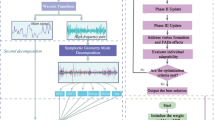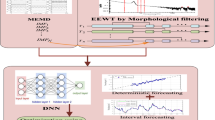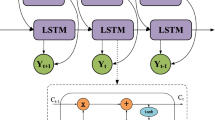Abstract
Ship motion (SHM) forecasting value is an important parameter for ship navigation and operation. However, due to the coupling effect of wind, wave, and current, its time series has strong nonlinear characteristics, so it is a great challenge to obtain accurate forecasting results. Therefore, considering the strong nonlinear of SHM time series, firstly, this paper decomposes the original time series into multiple intrinsic mode functions (IMF) using empirical mode decomposition (EMD) technology and then establishes a hybrid deep learning network for each IMF based on convolutional neural network (CNN) and gated recurrent unit (GRU) according to the characteristics of SHM time series. On this basis, the EMD-CNN-GRU (ECG) hybrid forecasting model of SHM is constructed by integrating a component forecasting model. Secondly, considering the difficulty of hyper-parameters selection of ECG model, this paper improves the butterfly optimization algorithm (BOA) based on quantum theory, designs the quantum coding rules of butterfly spatial position, establishes the optimization process of butterfly algorithm based on quantum coding, and then proposes the quantum butterfly optimization algorithm (QBOA). Finally, a hybrid forecasting approach integrating ECG and QBOA is proposed, namely ECG & QBOA. To evaluate the feasibility and performance of the proposed approach. A prediction experiment was carried out with the SHM data of a real ship. The results indicate that, compared with the other comparison models selected in this paper, ECG-based models have significant higher forecasting accuracy (with MAPE values of 10.86% and 12.69% in two experiments, respectively, and with significant accuracy improvement of at least 10% than other compared models), and the QBOA has obtained more appropriate hyper-parameters combination of ECG model.










Similar content being viewed by others
Data Availability
The datasets generated during and analyzed during the current study are available from the corresponding author on reasonable request.
Abbreviations
- Ship motion (SHM):
-
Abbreviation of ship six degree of freedom motion
- Empirical mode decomposition (EMD):
-
A signal decomposition technique
- Intrinsic mode function (IMF):
-
The name of the sequence after EMD decomposition
- Convolutional neural network (CNN):
-
A deep learning network
- Gate recurrent unit (GRU):
-
A deep learning network
- Long short-term memory (LSTM):
-
A deep learning network
- Depth neural network (DNN):
-
A deep learning network
- Butterfly optimization algorithm (BOA):
-
A parameter optimization algorithm
- Quantum butterfly optimization algorithm (QBOA):
-
An improved BOA
- EMD-CNN-GRU (ECG):
-
Abbreviation of EMD-CNN-GRU hybrid model
- Artificial neural network (ANN):
-
Traditional neural network
- Autoregressive moving average (ARMA):
-
Time series prediction model
- Autoregressive integrated moving average (ARIMA):
-
Time series prediction model
- Support vector machine (SVM):
-
Time series forecasting method
- Mean absolute percentage error (MAPE):
-
Prediction and evaluation index
- Root mean square error (RMSE):
-
Prediction and evaluation index
- X(t):
-
Original ship motion time series
- X max(t):
-
An upper envelope sequence composed of the maximum of X(t)
- X min(t):
-
A lower envelope sequence composed of the minimum of X(t)
- m(t):
-
The sequence of the average values of Xmax(t) and Xmin(t)
- IMF(t):
-
The sequence of Intrinsic Mode Function
- r n(t):
-
The residual sequence
- x k :
-
xk Represents a feature map of the input tensor of the layer k, which is a one-dimensional tensor
- w k :
-
Filters weight of layer k
- b k :
-
Bias terms
- C :
-
The size of filters
- D :
-
The depth of the feature map
- m :
-
The size of the pooling
- s :
-
The step of pooling
- \(\phi\) :
-
Activation function
- x t :
-
The input sequence of GRU in the tth time step
- h t :
-
Hidden layer output in the tth time step
- \(\tilde{h}_{t}\) :
-
Candidate state in the tth time step
- z t :
-
Update gate
- r t :
-
Reset gate
- W r, W z, W t and W :
-
Weight parameters
- f :
-
f Stands for flavor intensity
- c :
-
c Is sensory modal
- a :
-
a Is the power component
- I :
-
I Is the stimulus intensity related to the fitness value
- g θ * :
-
g* Represents the optimal butterfly position found in the current iteration
- r :
-
r Is a random number
- P :
-
P Is switch probability
- P r :
-
PR is a random number
- μ and ν :
-
μ And v represent the probability amplitude of the basic state
- x j :
-
xj Represents the position of the ith butterfly
- x ij max :
-
xijMax represents the upper search limit of xij
- x ij min :
-
xijMin represents the lower search limit of xij
- θ :
-
θ Represents phase
- ∆θ :
-
∆θ Represents phase increment
- d i :
-
The ith number in the time series
- D i :
-
Normalization result of the ith number
- d max :
-
Maximum in time series
- D min :
-
The minimum value in time series
- \(\hat{d}\) :
-
The predicted value of the model
- f fitness :
-
Fitness function value of the algorithm
- L t :
-
Model loss on training data set
- L v :
-
Model loss on validation data set
References
Wiener, N.: Extrapolation, Interpolation, and Smoothing of Stationary Time Series with Engineering, Applications. MIT Press, Cambridge MA, 10–14, 1949. https://ieeexplore.ieee.org/book/6267356
Bates, M.R., Bock, D.H., Powell, F.D.: Analog computer applications in predictor design. IRE Trans. Electron. Comput. 6, 143–153 (1957). https://doi.org/10.1109/TEC.1957.5222011
Kaplan, P.: A study of forecasting techniques for aircraft carrier motions at sea. J. Hydronaut. 3, 121–131 (1968). https://doi.org/10.2514/3.62814
Sidar, M., Doolin, B.: On the feasibility of real-time forecasting of aircraft carrier motion at sea. IEEE Trans. Autom. Control 28, 350–356 (1983). https://doi.org/10.1109/TAC.1983.1103227
Triantafyllou, M.S., Bodson, M.: Real time forecasting of marine vessel motions, using kalman filtering techniques. In: Offshore Technology Conference, 1982, pp. 159–173. https://doi.org/10.4043/4388-MS
Yumori, I.: Real time forecasting of ship response to ocean waves using time series analysis. In: Proceeding of OCEANS 81, 16–18 Sept. Boston, MA, USA. https://doi.org/10.1109/OCEANS.1981.1151574 (1981)
Zhao, X.R., Peng, X.Y., Lu, S.P., Wei, W.N.: Extreme short forecasting of big ship motion having wave survey. J. Ship Mech. 7, 39–44 (2003). https://doi.org/10.3969/j.issn.1007-7294.2003.02.005
Sun, L.H., Shen, J.H.: Application of the Grey topological method to predict the effects of ship pitching. J. Mar. Sci. Appl. 7, 292–296 (2008). https://doi.org/10.1007/s11804-008-7111-z
Yin, J.C., Zhou, Z.D., Xu, F., Wang, N.N.: Online ship roll motion forecasting based on grey sequential extreme learning machine. Neurocomputing 129, 168–174 (2014)
Li, M.W., Geng, J., Han, D.F., Zheng, T.J.: Ship motion prediction using dynamic seasonal RvSVR with phase space reconstruction and the chaos adaptive efficient FOA. Neurocomputing 174, 661–680 (2016). https://doi.org/10.1016/j.neucom.2015.09.089
Li, M.W., Geng, J., Hong, W.C., Zhang, L.D.: Periodogram estimation based on LSSVR-CCPSO compensation for forecasting ship motion. Nonlinear Dyn. 97, 2579–2594 (2019). https://doi.org/10.1007/s11071-019-05149-5
Khan, A., Bil, C., Marion, K.: Theory and application of artificial neural networks for the real time forecasting of ship motion. In: Khosla, R., Howlett, R.J., Jain, L.C. (Eds), Knowledge-Based Intelligent Information and Engineering Systems (KES 2005), Lecture Notes in Computer Science, vol. 3681, pp. 1064–1069. Springer, Berlin. https://doi.org/10.1007/11552413_151 (2005)
Kuremoto, T., Kimura, S., Kobayashi, K., Obayashi, M.: Time series forecasting using a deep belief network with restricted Boltzmann machines. Neurocomputing 137, 47–56 (2014). https://doi.org/10.1016/j.neucom.2013.03.047
Akita, R., Yoshihara, A., Matsubara, T., Uehara, K.: Deep learning for stock forecasting using numerical and textual information. In: Proceeding of IEEE/ACIS 15th International Conference on Computer and Information Science (ICIS), Okayama, Japan, 26–29 June 2016, pp. 1–6. https://doi.org/10.1109/ICIS.2016.7550882
Chen, J., Zeng, G., Zhou, W., Du, W., Lu, K.: Wind speed forecasting using nonlinear-learning ensemble of deep learning time series forecasting and extremal optimization. Energy Convers. Manag. 165, 681–695 (2018). https://doi.org/10.1016/j.enconman.2018.03.098
Suhermi, N., Suhartono, D.D., Prastyo, B.: Ali, Roll motion forecasting using a hybrid deep learning and ARIMA model. Proc. Comput. Sci. 144, 251–258 (2018). https://doi.org/10.1016/j.procs.2018.10.526
Wang, Y., Soltani, M., Hussain, D.M.A.: Ship attitude forecasting based on Input Delay Neural Network and measurements of gyroscopes. In: Proceedings of the 2017 American Control Conference (ACC), pp. 4901–4907. https://doi.org/10.23919/ACC.2017.7963714 (2017)
Peng, X., Zhang, B., Zhou, H.: An improved particle swarm optimization algorithm applied to long short-term memory neural network for ship motion attitude forecasting. Trans. Inst. Meas. Control. 41, 4462–4471 (2019). https://doi.org/10.1177/0142331219860731
Zhang, W., Wu, P., Peng, Y., Liu, D.: Roll motion forecasting of unmanned surface vehicle based on coupled CNN and LSTM. Future Int. 11, 243 (2019)
Liu, Y.H., Duan, W.Y., Huang, L.M., Duan, S.L., Ma, X.W.: The input vector space optimization for LSTM deep learning model in real-time forecasting of ship motions. Ocean Eng. 213, 107681 (2020). https://doi.org/10.1016/j.oceaneng.2020.107681
Lee, D., Lee, S.: Motion predictive control for DPS using predicted drifted ship position based on deep learning and replay buffer. Int. J. Naval Arch. Ocean Eng. 12, 768–783 (2020). https://doi.org/10.1016/j.ijnaoe.2020.09.004
Wang, Y., Wang, H., Zou, D., Fu, H.: Ship roll prediction algorithm based on Bi-LSTM-TPA combined model. J. Mar. Sci. Eng. 9(4), 384 (2020). https://doi.org/10.3390/jmse9040387
Huang, L.M., Duan, W.Y., Han, Y., Yu, D.H.: A hybrid AR-EMD-SVR model for the short-term prediction of nonlinear and non-stationary ship motion. J. Ship Mech. 19, 1033–1049 (2015). https://doi.org/10.3969/j.issn.1007-7294.2015.09.002
Fan, G.F., Peng, L.L., Hong, W.C., Sun, F.: Electric load forecasting by the SVR model with differential empirical mode decomposition and auto regression. Neurocomputing 173, 958–970 (2016)
Wang, X.P., Wang, Y.Q.: A Hybrid Model of EMD and PSO-SVR for short-term load forecasting in residential quarters. Math. Probl. Eng. Article ID: 9895639. https://www.hindawi.com/journals/mpe/2016/9895639/ (2016)
He, K.J., Wang, H.Q., Du, J.Z., Zou, Y.C.: Forecasting electricity market risk using empirical mode decomposition (EMD)—based multiscale methodology. Energies 9, 931 (2016)
Bi, S.B., Bi, S.G., Chen, X., Ji, H., Yin, L.: A climate forecasting method based on EMD and ensemble forecasting technique. Asia-Pacific J. Atmos. Sci. 54, 611–622 (2018). https://doi.org/10.1007/s13143-018-0078-z
X.X. Liu, A.B. Zhang, C.M. Shi, H.F. Wang, Filtering and multi-scale RBF forecasting model of rainfall based on EMD method, In: Proceeding of 2009 First International Conference on Information Science and Engineering (CISE 2009), Nan**g, China, 26–28 Dec. 2009, Accession Number: 11281301. https://ieeexplore.ieee.org/document/5455288
**ang, Y., Guo, L., He, L.H., **a, S.L.: Wang, Wang, A SVR–ANN combined model based on ensemble EMD for rainfall forecasting. Appl. Soft Comput. 73, 874–883 (2018)
Zhang, C., Wei, H.K., Zhao, J.S., Liu, T.H., Zhu, T.T., Zhang, K.J.: Short-term wind speed forecasting using empirical mode decomposition and feature selection. Renew. Energy 96, 727–737 (2016)
Kang, A.Q., Tang, Q.X., Yuan, X.H., Lei, X.H., Yuan, Y.B.: Short-term wind speed forecasting using EEMD-LSSVM model. Adv. Meteorol. (2017). https://doi.org/10.1155/2017/6856139
Hong, W.C., Li, M.W., Geng, J., Zhang, Y.: Novel chaotic bat algorithm for forecasting complex motion of floating platforms. Appl. Math. Model. 72, 425–443 (2019). https://doi.org/10.1016/j.apm2019.03.031
Zhou, B., Shi, A.G.: Empirical mode decomposition based LSSVM for ship motion forecasting. In: Guo, C., Hou, Z.G., Zeng, Z. (Eds) 2013 International Symposium on Neural Networks (ISNN 2013) Advances in Neural Networks, Lecture Notes in Computer Science, vol. 7951, pp. 319–325. Springer, Berlin, Heidelberg. https://doi.org/10.1007/978-3-642-39065-4_39
Duan, W.Y., Huang, L.M., Han, Y., Zhang, Y.H., Huang, S.: A hybrid AR-EMD-SVR model for the short-term forecasting of nonlinear and non-stationary ship motion. J. Zhejiang Univ. Sci. A 16, 562–576 (2015). https://doi.org/10.1631/jzus.A1500040
Nie, Z.H., Shen, F., Xu, D.J., Li, Q.H.: An EMD-SVR model for short-term forecasting of ship motion using mirror symmetry and SVR algorithms to eliminate EMD boundary effect. Ocean Eng. 217, 107927 (2020). https://doi.org/10.1016/j.oceaneng.2020.107927
Rere, L.M.R., Fanany, M.I., Arymurthy, A.M.: Simulated annealing algorithm for deep learning. Proc. Comput. Sci. 72, 137–144 (2015). https://doi.org/10.1016/j.procs.2015.12.114
Arora, S., Singh, S.: Butterfly optimization algorithm: a novel approach for global optimization. Soft. Comput. 23, 715–734 (2019). https://doi.org/10.1007/s00500-018-3102-4
Arora, S., Singh, S.: An improved butterfly optimization algorithm with chaos. J. Intell. Fuzzy Syst. 32, 1079–1088 (2017). https://doi.org/10.3233/JIFS-16798
Mohammadi, A., Hamid Zahiri, S.: Inclined planes system optimization algorithm for IIR system identification. Int. J. Mach. Learn. Cybern. 9, 541–558 (2018). https://doi.org/10.1007/s13042-016-0588-x
Mirjalili, S., Mohammad Mirjalili, S., Lewis, A.: Grey wolf optimizer. Adv. Eng. Softw. 69, 46–61 (2014). https://doi.org/10.1016/j.advengsoft.2013.12.007
Fei, Z., Wu, Z., **ao, Y., He, W.: A new short-arc fitting method with high precision using Adam optimization algorithm. Optik 212, 164788 (2020). https://doi.org/10.1016/j.ijleo.2020.164788
Arora, S., Singh, S., Yetilmezsoy, K.: A modified butterfly optimization algorithm for mechanical design optimization problems. J. Braz. Soc. Mech. Sci. Eng. 40, 21 (2018). https://doi.org/10.1007/s40430-017-0927-1
Arora, S., Anand, P.: Learning automata-based butterfly optimization algorithm for engineering design problems. Int. J. Comput. Mater. Sci. Eng. 7, 1850021 (2018). https://doi.org/10.1142/S2047684118500215
Han, K.H., Kim, J.H.: Quantum-inspired evolutionary algorithm for a class of combinatorial optimization. IEEE Trans. Evol. Comput. 6, 580–593 (2002). https://doi.org/10.1109/TEVC.2002.804320
Zhang, X., Shen, F., Zhao, J., Yang, G.: Time series forecasting using GRU neural network with multi-lag after decomposition. In: Liu, D., **e, S., Li, Y., Zhao, D., El-Alfy, E.S. (Eds) Neural Information Processing (ICONIP 2017), Lecture Notes in Computer Science, vol. 10638, pp. 523–532. Springer, Cham. https://springer.longhoe.net/chapter/10.1007%2F978-3-319-70139-4_53 (2017)
Luo, L.: Network text sentiment analysis method combining LDA text representation and GRU-CNN. Pers. Ubiquit. Comput. 23, 405–412 (2019). https://doi.org/10.1007/s00779-018-1183-9
**, C., **, S., Qin, L.: Attribute selection method based on a hybrid BPNN and PSO algorithms. Appl. Soft Comput. 12, 2147–2155 (2012). https://doi.org/10.1016/j.asoc.2012.03.015
Acknowledgements
The work is supported by the following project grants, National Key Research and Development Program of China (2019YFB1504403); High-tech Ship Technology Project (MC-202030-H04); Heilongjiang Excellent Youth Fund Project (YQ2021E015); National Natural Science Foundation of China (No.51509056); and Ministry of Science and Technology, Taiwan (MOST 110-2410-H-161-001).
Author information
Authors and Affiliations
Corresponding author
Ethics declarations
Conflict of Interest
The authors declare that they have no conflict of interest.
Additional information
Publisher's Note
Springer Nature remains neutral with regard to jurisdictional claims in published maps and institutional affiliations.
Rights and permissions
About this article
Cite this article
Li, MW., Xu, DY., Geng, J. et al. A ship motion forecasting approach based on empirical mode decomposition method hybrid deep learning network and quantum butterfly optimization algorithm. Nonlinear Dyn 107, 2447–2467 (2022). https://doi.org/10.1007/s11071-021-07139-y
Received:
Accepted:
Published:
Issue Date:
DOI: https://doi.org/10.1007/s11071-021-07139-y




